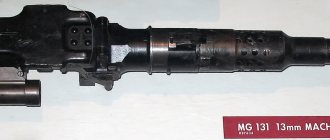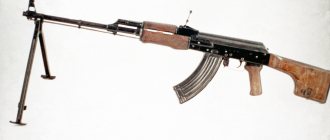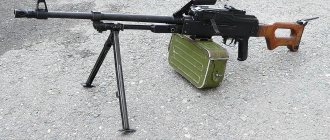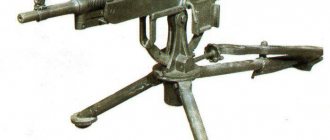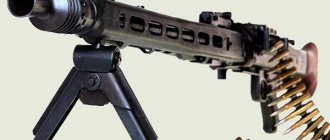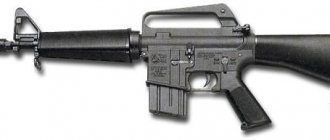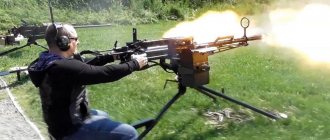Usage[edit]
The weapons were primarily intended for Italian infantry units, one machine gun per two, and later per one squad. Breda 30 was also installed on armored vehicles and motorcycles with sidecars. A small part of the machine guns was used by German units, where it was known under the designation MG 099(i)
.
The crew of the light machine gun consisted of two soldiers, a shooter and a gunner, who helped carry and load cartridges. The Breda 30 was trusted only by experienced soldiers, since handling it required precision and skill, and the machine gun itself was the most effective support weapon in the Italian infantry. Loaders were specially trained to quickly reload during combat.
Ultimately, the Breda 30's fire density was comparable to automatic carbines such as the American M1 Garand. For all its shortcomings, this machine gun was considered the most powerful weapon of the Italian infantry. Heavy machine guns were extremely rare among them, and the main rifle, the Carcano M91, was an outdated weapon that did not meet the requirements of the time.
Construction[edit]
The Breda 30 was a rather unique design for a light machine gun. The box magazine was attached to the right side and contained 20 cartridges secured with a special brass or steel clip. The entire structure of the magazine was fragile and easily damaged, which led to the failure of the machine gun. At the same time, the mechanisms required careful lubrication for operation, which led to difficulties in operating the machine gun in the dusty conditions of North Africa.
For ammunition, a weak 6.5x52 mm cartridge was used, which was not intended specifically for this machine gun and was poorly suited for its role. Subsequently, some of the guns were modified to work with a 7.35 mm caliber cartridge and received the index M37. But only a small part of the trunks underwent improvements.
He weighed 10.4 kg. The weapon had a bipod, a rifle stock and a pistol grip. The operating system was of two types: the first operated due to the recoil of a short-stroke barrel, the second - through the use of the energy of powder gases. When firing, the barrel moved back 12.7 mm and stopped; the bolt disengaged and continued to move backward. The bolt hit the shock absorber under the influence of the return spring and began to move forward, then the cartridge was fed into the chamber, the barrel was locked, and the firing pin was fired. The machine gun fired only in automatic mode.
Breda – from airplane to semi-automatic
Breda semi-automatic machines are very popular in Russia - they are sold at more than reasonable prices, are easy to use and do not break - and what else does a hunter need? We met with the owner of Breda, Mauro Marocchi, and he told us how he worked with Bruno Civolani, Breda made rails, planes and semi-automatics, how long Breda guns last, why Turkish guns are not as beautiful as Italian ones - and much more.
Carbine:
Mauro, tell us about the history of Breda
Mauro Morocchi:
It is very important to know the history of the Breda brand, because the history of this brand is the personification of the entire history of Italy.
Breda made steel, planes, trains, weapons, huge ships - Breda made everything. Today in Italy everyone knows about the Breda train – it’s a common noun.
Breda was the first company in Italy to produce semi-automatic machines
TO.
:
Mauro, our readers ask us – are Breda and Benelli technologically similar?
We constantly write on the Internet that in fact this is the same model. MM.:
Yes, this is true, since Breda and Benelli worked in close collaboration for a very long time, for some time Breda owned shares in Benelli. When we bought the Breda company, we continued the production of inertial semi-automatic machines, in addition, we still managed to catch Bruno Civollani himself - this is the designer who came up with the modern inertial semi-automatic machine.
He and I had a joint project - we produced the Breda Xanthos shotgun. Now the legendary inventor is no longer alive, but Breda Xanthos is still in production. Yes, almost all spare parts are the same for Breda and Benelli.
What greatly distinguishes the Breda from the Benelli is the barrel. We have our own barrel production technology and a very, very long history of their production.
An interesting fact is that small gun manufacturers used to specifically put the Breda stamp on their barrels; such a gun was easier to sell.
And Breda had its own brand of steel - only this alloy was used to make barrels at the factory. Old hunters have always known that Breda barrels are the best. We also had our own technology for the production of barrels - then they were made by forging, only everyone had cold forging, and Breda had hot forging.
Breda was also the first company to chrome-plate barrels.
Today we make barrels only by deep drilling - this method gives the steel excellent elasticity (very important for shotgunning) and strength.
This is a very expensive method! Imagine - we use 3.8 kg of steel to produce a barrel!
For reference, the weight of the whole gun - already with the butt, fore-end, trigger - is on average 3.3 - 3.4 kg. Imagine the gigantic waste generated by the production of each barrel.
But we believe that this is the only way to make an ideal barrel and we accept such losses.
The profile of the barrel is also of great importance - our barrels help greatly reduce recoil. The structure of the steel when drilling also makes the recoil much more comfortable.
Well, don’t forget that soldering a strip onto a drilled barrel can be done at very high temperatures - that’s why our strips don’t become unsoldered!
Previously, a significant part of our turnover came from hunters who came to us to upgrade their guns. They bought weapons from simpler companies than Breda, and they came to us for our barrel - they asked us to install our barrels on their guns. Because our trunks also produce excellent scree.
Arab countries, for example, adore our guns for their range. They buy guns from us with long barrels - 81 cm, fixed choke - and are happy to shoot very far. Moreover, they show excellent results even with a magnum cartridge!
We also came up with a new loading system. We work a lot with IPSC, and we came up with this know-how specifically for these shooters.
https://premiumgun.ru/katalog/?q=b12&s=%D0%98%D1%81%D0%BA%D0%B0%D1%82%D1%8C
We also have new magazine extensions - very cool! They are very, very accurately attached to the gun, it is easy to remove and clean.
K.:
Mauro, one of our readers asked us a question - she is now faced with a choice - an inexpensive gas-operated gun or an inertia-fired Breda Astro - the most inexpensive model produced under the Breda brand.
What advice would you give her? Breda Astro shotgun, the most inexpensive Breda model
https://premiumgun.ru/katalog/?q=astro&s=%D0%98%D1%81%D0%BA%D0%B0%D1%82%D1%8C
MM.
: Astro is the entry level into the world of Breda. We tried to make a gun as inexpensive as possible, for active use, for those who do not need cool aesthetics. But all other components, all components are made in the same way as on expensive versions of Breda Echo.
Breda Echo shotgun
https://premiumgun.ru/katalog/?q=echo&s=%D0%98%D1%81%D0%BA%D0%B0%D1%82%D1%8C
We have an even more inexpensive i-First model - the idea is the same, this is a gun for those who are just starting to hunt or have a very small purchasing budget. We created this model to compete with Turkish manufacturers. Again, the mechanisms and materials are the same as on the expensive versions, only the finishing of the gun has been simplified.
Breda iFirst – also a budget version
K.:
Mauro, our readers ask: after how many thousand shots does the Breda break for the first time?
MM
.: We do a lot of tests at the factory. But I like it better when guns are tested not by us, but by real hunters.
We have a client in Argentina - he keeps hunting grounds, and on the grounds he keeps weapons for those who come to him for money to hunt. You can imagine how people use guns that do not belong to them - extremely carelessly, they do not take care of them.
The owner of these lands told us that only Breda survived in these conditions.
TO.
:
Yes, your distributor in Russia gave us statistics - according to them, in all the years of Breda sales in Russia there has not been a single serious breakdown.
And experts estimate that a minor breakdown can occur no sooner than 1 in 1,700 guns, no more! MM.
: We didn’t have any serious breakdowns! Sometimes you need to change something small. Sometimes they bring us a gun - it won’t reload. A hunter, for example, walked on water for a long time, water was everywhere on his gun, the stock was wet for a long time, swollen, the gun was not cleaned after that. Of course it won't be able to shoot! But we just change the wood, JUST CLEAN the gun - and voila, everything is ok! There is no need to replace any spare parts.
Let's go back to Argentina! I have a recording from these lands - during the high season, one gun was fired very actively for several weeks - 5000 rounds per day! And so on for several days, when large companies come to hunt. I would not have believed it if they had told me that this was possible, but I read these facts in the accounting book for these lands. We only changed the extractor for them - that’s all.
Of course, sometimes wood can break - the butt or fore-end - if the gun is not used carefully, but this is also rare.
K.:
Question from readers - is it possible to go hunting with Breda 930
M.M.
: Of course, many people do this
BREDA 930 i
https://premiumgun.ru/katalog/?q=930&s=%D0%98%D1%81%D0%BA%D0%B0%D1%82%D1%8C
K.:
What percentage of parts for Breda are made in Turkey?
MM
.: The Lord is with you, 0%! This is why we started the project with Breda Astro and Breda iFirst, to convince people to pay a little extra and still get a 100% made in Italy gun.
TO.
:
Why pay this extra money at all?
The Turks are shooting too! MM
.:Well, it's like drinking Turkish vodka. This wouldn't occur to you, would it? WE have been making guns for several centuries, we have gained vast experience, production culture, we have understood what technologies and materials to use. You cannot accumulate such knowledge over several decades.
TO.
:
Mauro, let's return to your collaboration with Bruno Civolani. Tell us more about this, he is a legend in Russia. We know that he has created a completely innovative shotgun - the Breda Xanthos - for you.
Bruno Civolani, inventor of modern inertia
MM.
: Bruno himself was already very old when we started working, so we collaborated not only with him, but also with his grandson Andrea. Bruno made great use of Andrea's knowledge and skills. They worked on Breda Xanthos.
Breda Xanthos Damasco
https://premiumgun.ru/katalog/?q=damasco&s=%D0%98%D1%81%D0%BA%D0%B0%D1%82%D1%8C
The idea was to make an inertial semi-automatic with comfortable recoil.
Recoil is the only serious drawback of inertia engines, and Bruno really wanted to solve it. He came up with a new bolt design, made it heavy - due to its weight, it absorbs a significant part of the recoil.
Another goal is to make shooting, loading, and unloading as simple and understandable as possible for the shooter. Shooting a semi-automatic requires some training and practice, and Bruno wanted the hunter to shoot without thinking or having a complex sequence of actions in his head.
Bruno reduced the number of parts by 10% - the design of the Xanthos is very simple, and the gun is very easy to shoot - very few buttons and controls.
He wanted the receiver to be made of steel, but steel is very heavy!
But they figured out a way to make a receiver out of steel! We figured out how to make the walls of the box thin and at the same time very strong.
That is, Breda Xanthos is the only semi-automatic with a steel receiver
In addition, the entire receiver is made from a single piece of steel - one piece. This gives this part a huge margin of safety.
TO
.:
All gun owners are always very concerned about service and spare parts - how is Breda doing in Russia?
MM
.: I must say that we work with a huge number of countries, and no company takes service and the purchase of spare parts as seriously as our Russian distributor. The armory is our best partner in this regard.
TO
.:
Let's look at the Breda model range.
There are 4 lines of inertia: - Xanthos, which we described in detail
— Echo is a classic, understandable and familiar semi-automatic
— Titano
—Hermes
Titano and Hermes - what are these models?
MM
.: Titano is technically an analogue of Echo, it is a classic inertia semi-automatic. The difference is that this model is made very expensively: high-class wood, with a rich structure, very expensive, high-quality engravings.
Breda Titano
https://premiumgun.ru/katalog/?q=titano&s=%D0%98%D1%81%D0%BA%D0%B0%D1%82%D1%8C
For this series of guns, we are collaborating with Bottega Giovanelli - this is our most expensive studio that makes engravings for Custom level weapons.
The Ermes series is a tribute to an old, very popular model. As we said, Breda was the first company in the world to make semi-automatics, and the most popular model was the Antares. We decided to make a replica of this gun, very famous in Italy, but only, of course, from modern materials. A distinctive feature of this gun was the receiver, which consisted of two parts.
Breda Ermes
https://premiumgun.ru/katalog/?q=ermes&s=%D0%98%D1%81%D0%BA%D0%B0%D1%82%D1%8C
What’s interesting is that for the old Antares model, if I’m not mistaken, they started producing it in 1954, we are still producing spare parts. That is, if you are the happy owner of this model and you need repairs, there will be no problems with the parts.
You can watch this interview on our YouTube channel WEAPONS COMPANY PREMIUM, here is the link
Story
The Breda Model 31 was a licensed copy of the French Hotchkiss M1929.[3] machine gun. Breda acquired the production license in 1929, but it did not enter production until 1931. The Model 31 was often installed in single and twin mounts aboard surface ships and in vanishing twin mounts aboard submarines.[4] The Model 31 was intended to provide short-range air defense, but like its counterparts in other countries, these small-caliber guns proved unable to defend against low-level torpedo bombers or high-altitude bombers because their bullets were too small. light and close combat.[5] Although it was a reliable pistol with good performance, it was later replaced by the Breda 20/65 Mod. 1935
Notes
- "13.2×96 Hotchkis Short / MUNICION.ORG." www.municion.org
. Archived from the original on 2019-03-27. Received 2019-03-30. - DiGiulian, Tony. "Italy 13.2 mm / 75.7 (0.52") anti-aircraft machine gun model 1931 - NavWeaps ". www.navweaps.com
. Retrieved 2017-03-09. - DiGiulian, Tony. "France, 13.2 mm (0.5 in) Model 1929 - NavWeaps." www.navweaps.com
. Retrieved 2017-03-09. - Campbell, John (01/01/2002). Naval weapons of the Second World War
. Naval Institute Publishing House. ISBN 0870214594. OCLC 51995246. - DiGiulian, Tony. "Italy 13.2 mm / 75.7 (0.52") anti-aircraft machine gun model 1931 - NavWeaps ". www.navweaps.com
. Retrieved 2017-03-09. - Campbell, John (01/01/2002). Naval weapons of the Second World War
. Naval Institute Publishing House. ISBN 0870214594. OCLC 51995246.
Disadvantages[edit]
Among the disadvantages of weapons are:
- The need for oil to lubricate the cartridges.
- 20-round magazines are fragile, unreliable when feeding a cartridge, and slow to load.
- Low technology in production.
- The absence of a handle on the quick-change barrel, which turned replacing a hot barrel in combat conditions into a complex procedure.
- Low rate of fire.
- Weak cartridge (630 m/s). The Italian cartridge was not developed specifically for this machine gun. The Italian army simply used an unusually small cartridge for the period in their rifles.
Marine use
Ship classes on which the Breda Model 1931 was installed include:
- Adua-class
- Archimedes class
- Argo class
- Balilla class
- Brin class
- Cagni-class
- Calvi class
- Cyclone class
- Conte di Cavour class
- Curtaton class
- Flutto-class
- Foka class
- Folgor-class
- Freccia-class
- Giussano-class
- Glauco-class
- Liuzzi-class
- Maestrale-class
- Marcello-class
- Marconi-class
- Navigator-class
- Oriani-class
- Orsa-class
- Perla-class
- Sauro-class
- Sella class
- Soldier class
- Spica class
- Squalo class
- Trento class
- Turbine class
- Zara-class
